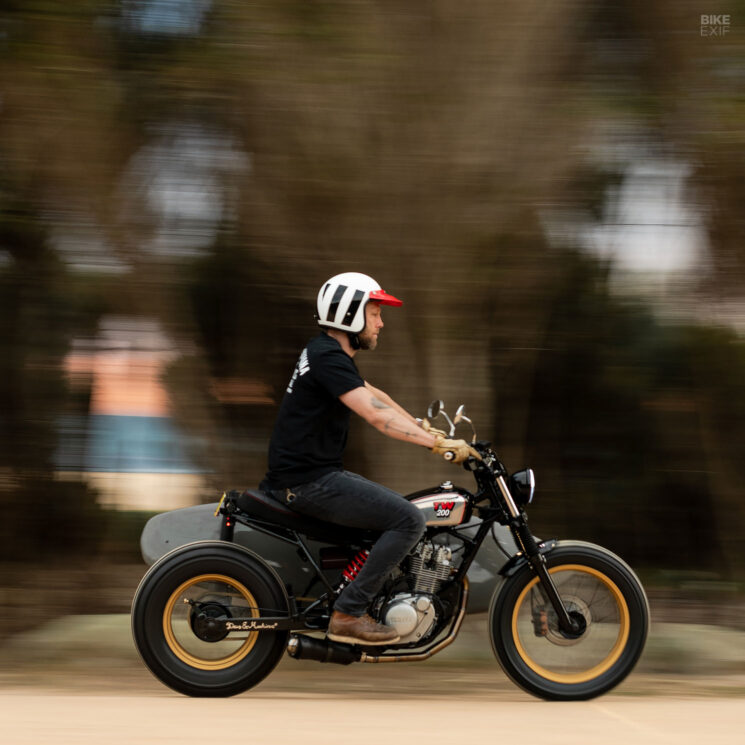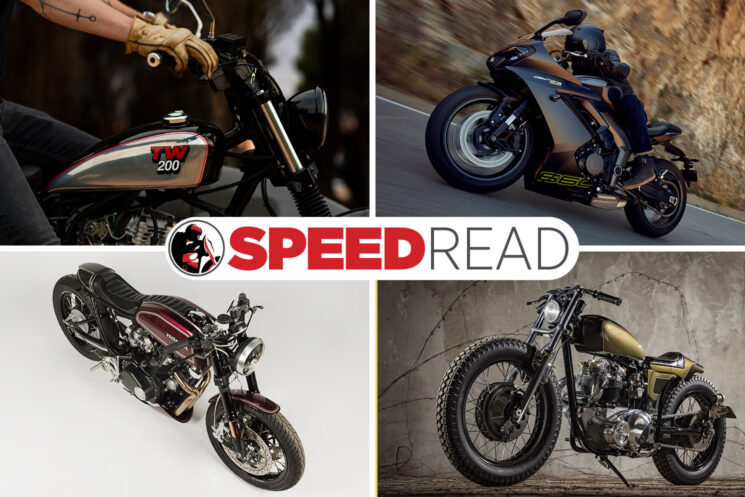
Our first Speed Read of the year has something for everyone. We kick off with news of the new Triumph Daytona 660, then profile a sharp Honda CB450 café racer from the US. A vintage Triumph from Heiwa MC and a cheeky Yamaha TW200 from Deus take us home.
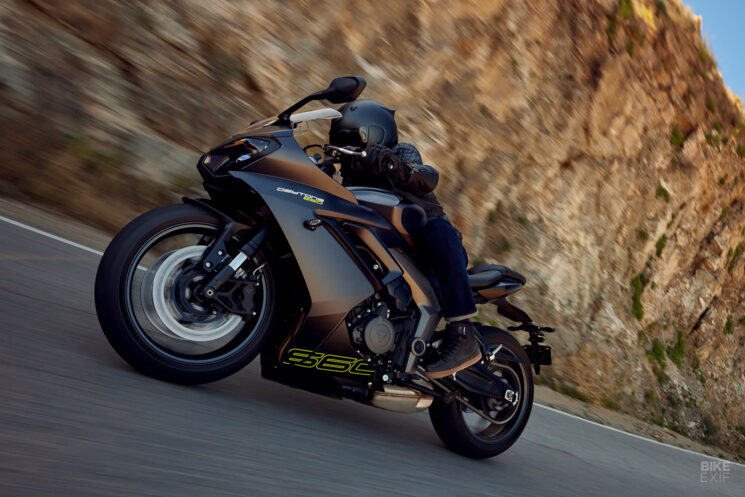
Triumph Daytona 660 Fans of the brilliant Triumph Daytona were treated to good news this week, as the British marque announced the return of the Daytona name to its line-up… with one major caveat. Officially named the Triumph Daytona 660, the new middleweight sportbike is based on the Trident 660 roadster, and not the phenomenal Street Triple 765.
To be fair, the Daytona 660 is much more than just a Trident 660 with fairings. Triumph has improved the 660 cc triple-cylinder mill, pushing its power output to 95 hp and torque to 69 Nm. It hits peak power at 11,250 rpm, redlines at 12,650 rpm, and has over 80 percent of its torque available from 3,125 rpm.
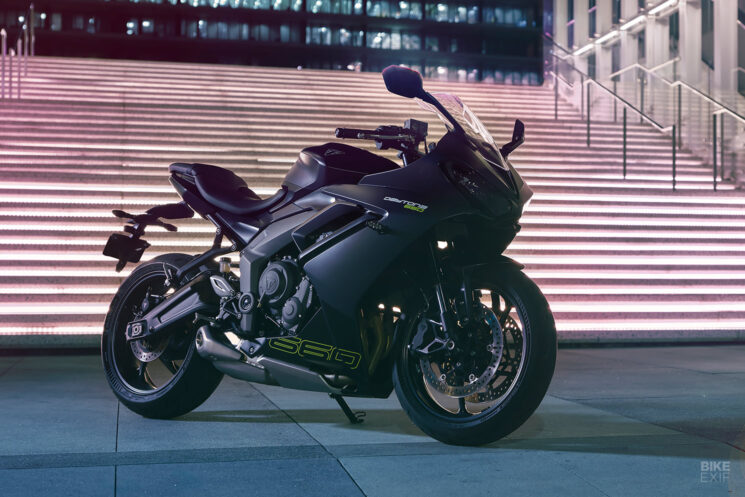
The Daytona 660’s frame is different from the Trident’s too, likely tweaked with lessons learned from the development of Triumph’s Moto2 prototype. 41 mm big-piston Showa forks sit up front, with a preload-adjustable Showa mono-shock out back. The Daytona 660 borrows its 17” wheels from the Street Triple 765 RS, with two four-piston brake calipers up front and a single disc brake out back.
Visually, the new Daytona 660 strikes a superb balance between the look of Triumph’s current crop of roadsters and the sporty but restrained vibe of the previous Daytona. It gets a full fairing with fairing-mounted mirrors, clip-ons, rear-set pegs, and split saddles with an 810 mm seat height for the rider. It also gets a brand new exhaust that looks identical to the Trident 660’s exhaust, but is apparently different.
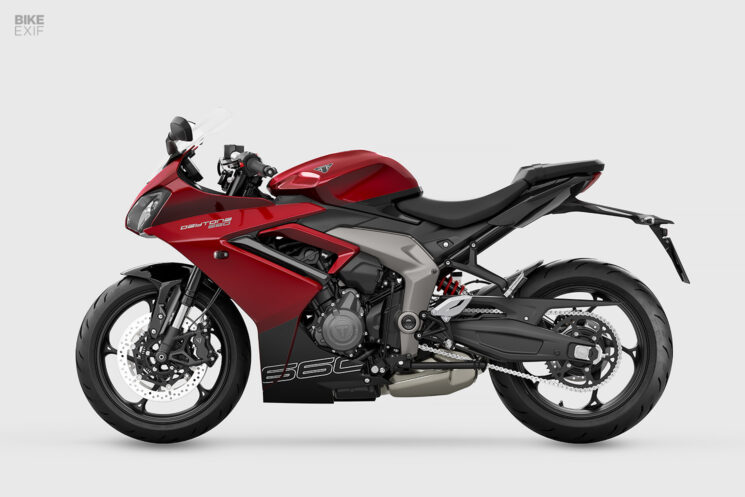
The Daytona 660’s electronics package is standard Triumph fare. You get three switchable rider modes, traction control, and ABS, with a quick-shifter available as an optional extra. LED lighting and a unique TFT display round out the package.
What the Daytona 660 doesn’t have, is the engine, power and torque figures, fully-adjustable Showa forks and Öhlins rear shock, and top-shelf Brembo brakes of the Street Triple 765 RS. Triumph is touting the new Daytona 660 as a “best in class” offering, but it’s hard not to pine for the Street Triple’s performance. Because while the Trident 660 is a great motorcycle, the Street Triple 765 RS is an exceptional motorcycle.
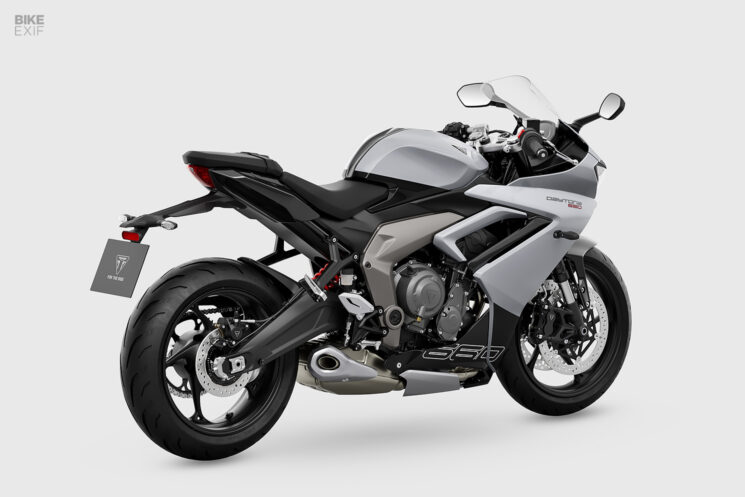
While the 2024 TriumphDaytona 660 looks good enough on paper, it might be too vanilla for die-hard fans of the Daytona. We sincerely hope that a Daytona 765 is waiting in the wings—and if it is, we’re wondering why it didn’t break cover first. [Triumph Motorcycles]
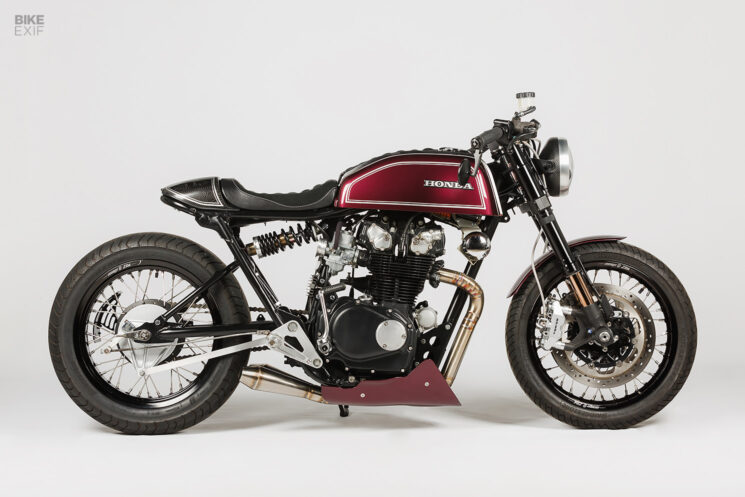
Honda CB450 by Mile Zero Racers Based in Rochester, New York, Thomas Manno has only built two motorcycles under the banner of Mile Zero Racers—but he’s already established a signature style. Both bikes are Honda CB café racers, and both look like they were built as much for speed as for style. But there’s also a deeper connection…
The first bike is a Honda CB750 that Thomas started working on two years ago. During that project, his brother bought a Honda CB450 for Thomas to ride around on while the CB750 was on the bench. Once the CB750 was done, Thomas worked his magic on the CB450—and then gave it back to his brother for his 30th birthday.
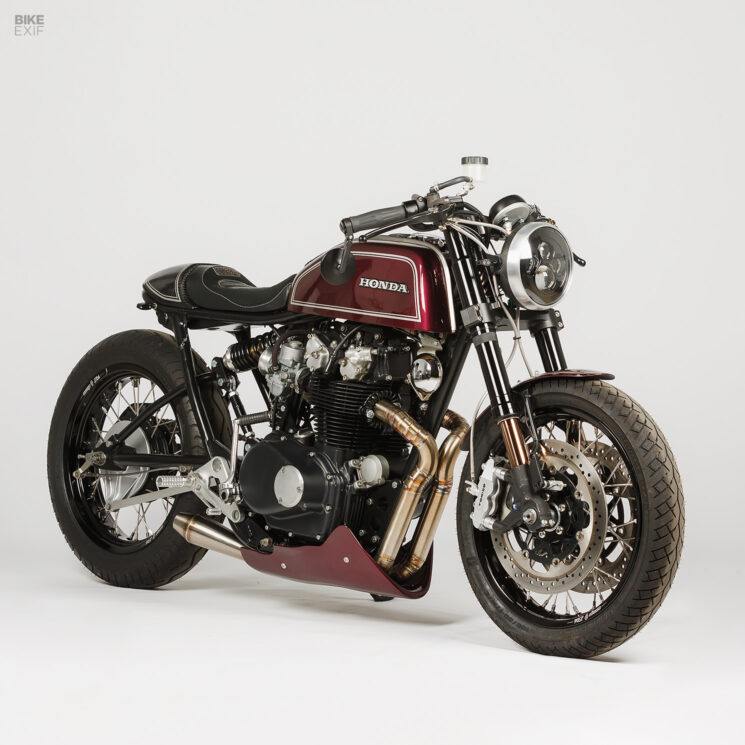
“The idea of this bike was to completely change the perspective of what is possible for the CB450 platform,” says Thomas. “I set the bar high with the previous CB750 build, so it was my mission to push the limits of my abilities and make the 450 build a complete challenge. Meaning pushing myself to complete the build with mostly everything made in-house, rather than purchased off the shelf.”
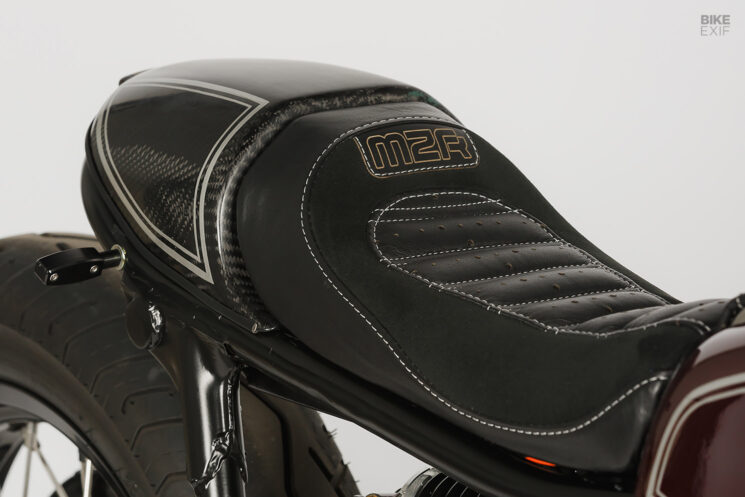
The CB450’s engine was healthy for its age, so all it needed was a new set of gaskets and an exterior refresh. It now inhales through a pair of velocity stacks with mesh covers and exhales via a custom-made exhaust system that snakes its way through a handmade belly pan. Another local workshop, The Motoworks, supplied the turn signals, headlight, mirror, and rear-sets, plus a control unit to rewire the bike with.
The Motoworks also sent over a custom front hub and new yokes, so that Thomas could upgrade the front-end with a set of Suzuki GSX-R forks and brakes. Next, Thomas converted the rear end from a dual- to single-shock arrangement. Both wheels were re-laced with fresh Warp 9 rims.
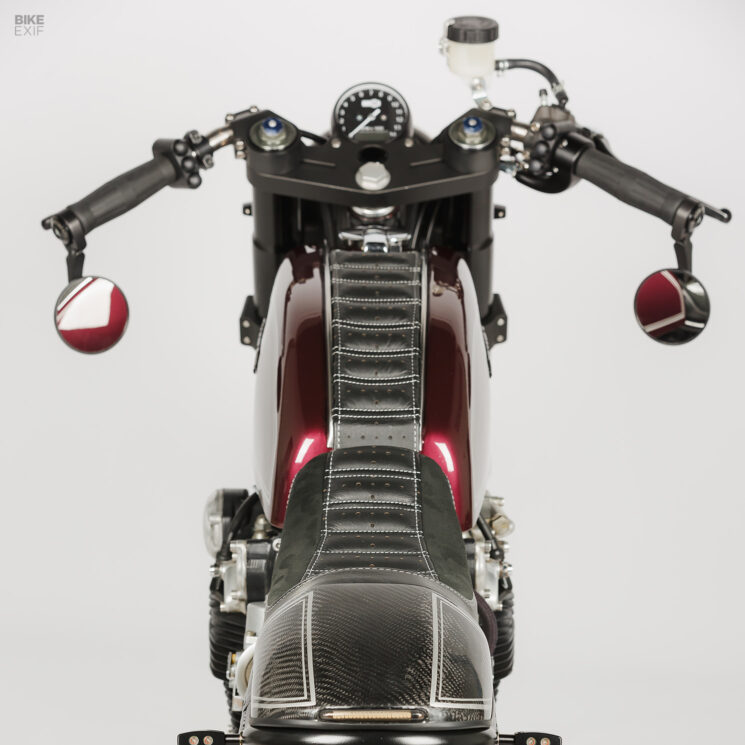
As for the bodywork, a Honda CB200 fuel tank sits up top, fettled to fit on the CB450’s frame. Thomas modified the subframe for a tighter kicked-up effect, then built a carbon fiber tail bump, mixing classic café racer style with modern materials. Look closely, and you’ll spot that the headlight bucket is also carbon fiber.
The upholstery is particularly stylish; a perforated design that continues up and over the fuel tank. Raised clip-ons adorn the cockpit, along with fresh grips, bar-end mirrors, and an aftermarket speedo. A glorious wine-red livery adds the perfect finishing touch. [Mile Zero Racers]
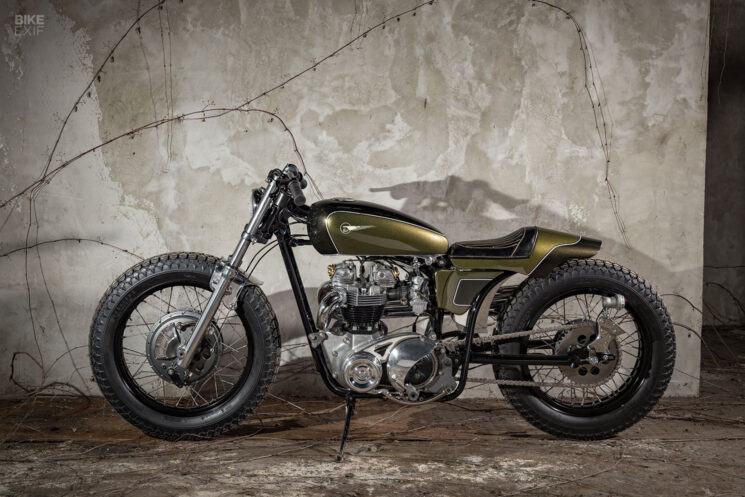
Triumph TR6 by Heiwa MC Tapered fuel tanks, stepped tail cowls, narrow handlebars—there’s an elegance to Kengo Kimura’s signature vintage Triumph builds that’s hard to put into words. But once you look beyond the handcrafted bodywork and luscious paint, each bike has a wealth of unique details to take in.
This 1970-model Triumph TR6 is a prime example of the type of work that put Kimura-san’s shop, Heiwa MC, on the map.

Kengo’s hand is evident in the custom fuel tank, tail cowl, and side covers. But keen eyes will notice that the frame is also bespoke, as is the mono-shock swingarm. (The shock is hard to spot because it’s hidden away by a handcrafted oil tank).
The side covers form part of the air cleaner setup, directing air to the Mikuni VM32 carbs. High-mounted exhaust headers make noise via a pair of stacked reverse cone mufflers.
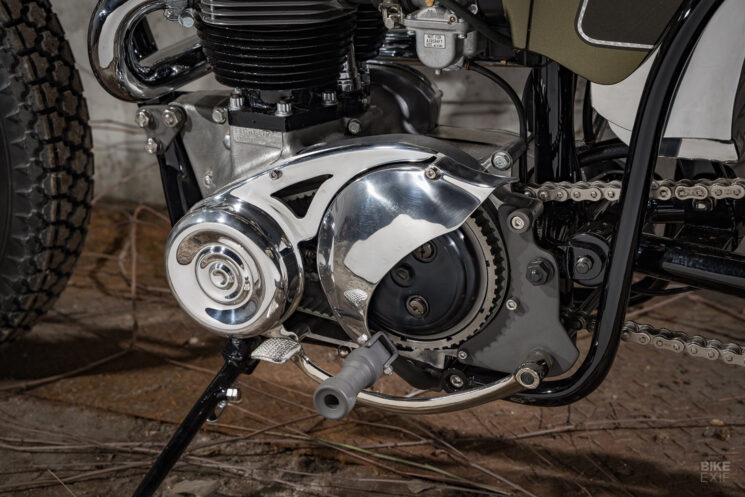
A set of Kayaba forks sit up front, stabilized by a custom-made fork brace. The TR6 rolls on 19F/18R wheels, with a Robinson twin leading shoe drum brake hub up front. Kengo also fabricated the handlebars, controls, footpegs, headlight cowl, and taillight.
Take a peek around the left side of the bike, and you’ll spot its most unique feature. Kengo converted the primary drive to a belt system, protected by a partially open three-piece cover.

Then there’s the paint job—a captivating mix of olive green metallic and dark green metallic, separated by silver leaf striping. Executed by Shakin’ Speedgraphix, it’s a livery worthy of Kengo’s handiwork. [Heiwa MC | Images by Kazuo Matsumoto]
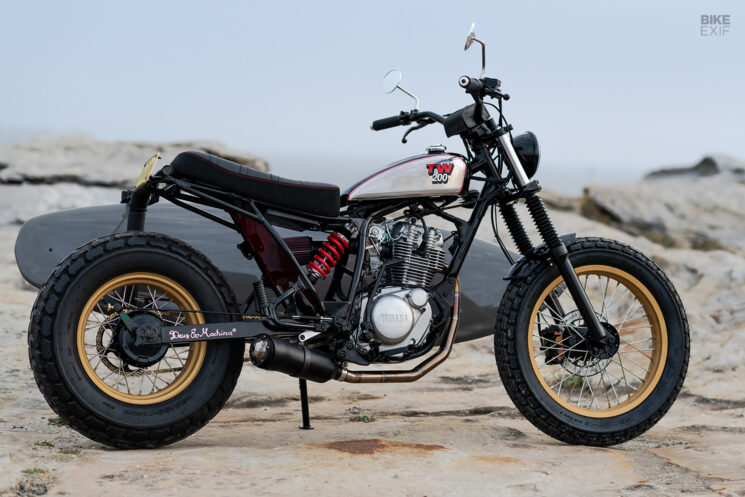
Yamaha TW200 by Deus ex Machina The TW200 and XT500 are two of the most loved motorcycles that Yamaha ever produced. So what better way to celebrate their respective legacies, than by rolling all of their style into one feisty custom motorcycle? Meet the Deus XTW200; a Yamaha TW200 that’s been customized to look like the fat-tired, beach-cruising little brother that the XT500 never had.
The XTW200 is the work of Jeremy Tagand at Deus ex Machina’s Sydney shop. The project started as a true barn find—a neglected TW200 with a thrashed engine, in dire need of love. Deus put the engine through a full rebuild, then added a Keihin FCR carburetor and a custom-made exhaust with a Supertrapp muffler.
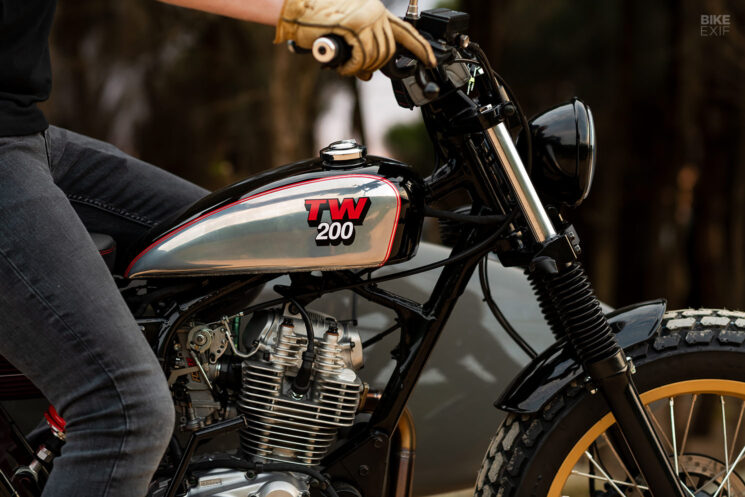
The frame was tidied up too, and then powder-coated in satin black. Every last nut and bolt was either zinc coated or replaced, and the previously lengthened swingarm was brought back to a more reasonable length. A new set of YSS shocks prop up the rear, while the OEM front forks were refurbished with fresh internals.
Deus also rebuilt the wheels with new rims and spokes, finishing them in ceramic-coated champagne gold as a nod to the XT500s of the late 70s and early 80s.

An alloy trackmaster-style fuel tank sits up top, finished in the iconic early-80s XT500 scheme. A vintage motocross-style seat sits behind it, upholstered in gripper vinyl and Alcantara. Subtle touches include the XT500-inspired ‘TW200’ tank logos, branding that’s been stitched into the seat, and a hidden rear splash guard.
The cockpit sports a set of wide ProTaper flat track handlebars, fitted with Motogadget grips, and a throttle and switches from Messner Moto. The chunky bar pad has been modified to host a Motogadget speedo and LED warning light strip. A Highsider headlight pokes out the front, with Kellermann turn signals to keep things street-friendly.
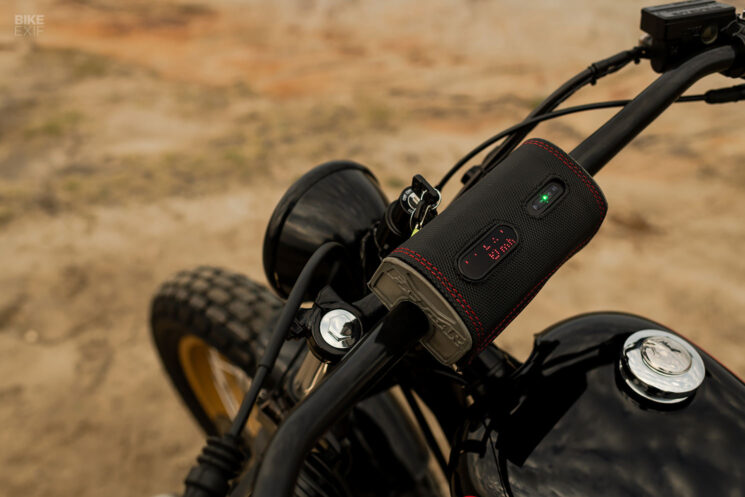
A shortened seat was sourced from Japan and then re-foamed for a more VMX shape and adorned in gripper vinyl and Alcantara, accented by the red stitching and branding in the rear. An alloy trackmaster-style tank sporting the infamous, early 80’s XT500 colour scheme and graphics was perched atop the refurbed frame.
In the cockpit, a set of Protaper EVO tracker bars hold the Motogadget Motoscope Mini and Mo.sign recessed into the bar pad- Which is also handsomely dressed in the gripper material from the seat. Messner Moto throttle and switches and Motogadget grips finish off the bars perfectly.

Deus has always celebrated the intersection of motorcycling and surfing, so it’s only fitting that this Yamaha TW200 has room for a surfboard. With a Supertrapp silencer slung under the bike, it should be just rowdy enough to pique the interest of your local beachgoers as you trundle down to the beach. [Deus Customs | Images by Chris Grundy]
